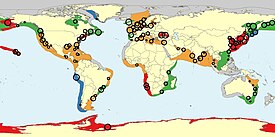
Back علم البيئة التجمعي Arabic Demekologiya Azerbaijani Дэмэкалогія Byelorussian Populacijska ekologija BS Populationsökologie German Populaciekologio Esperanto Ecología de poblaciones Spanish Demökoloogia Estonian Populazioen ekologia Basque بومشناسی جمعیت Persian

Increase (high certainty)
Increase (low certainty)
Stable/variable
Decrease
No data
Population ecology is a sub-field of ecology that deals with the dynamics of species populations and how these populations interact with the environment, such as birth and death rates, and by immigration and emigration.[2]
The discipline is important in conservation biology, especially in the development of population viability analysis which makes it possible to predict the long-term probability of a species persisting in a given patch of habitat.[3] Although population ecology is a subfield of biology, it provides interesting problems for mathematicians and statisticians who work in population dynamics.[4]
- ^ Brotz, Lucas; Cheung, William W. L; Kleisner, Kristin; Pakhomov, Evgeny; Pauly, Daniel (2012). "Increasing jellyfish populations: Trends in Large Marine Ecosystems". Hydrobiologia. 690 (1): 3–20. doi:10.1007/s10750-012-1039-7.
- ^ Odum, Eugene P. (1959). Fundamentals of Ecology (Second ed.). Philadelphia and London: W. B. Saunders Co. p. 9, 546. ISBN 9780721669410. OCLC 554879.
- ^ AAAS Atlas of Population and Environment
- ^ Kingsland, S. (1995). Modeling Nature: Episodes in the History of Population Ecology. University of Chicago Press. ISBN 978-0-226-43728-6.
© MMXXIII Rich X Search. We shall prevail. All rights reserved. Rich X Search